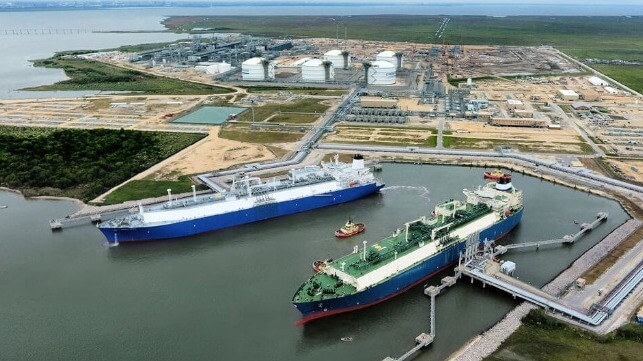Projects Seek to Further Grow U.S. LNG Export Capacity

With global demand for liquified natural gas expected to continue to grow significantly in the near term, efforts are underway to expand U.S. export capabilities. The U.S. is currently rivaling Qatar as the largest exporter and several new projects are moving toward permitting to further grow U.S. capabilities.
Cheniere Partners, which owns Sabine Pass LNG, the largest export terminal in the continental United States, located in Cameron Parish, Louisiana, told investors during its conference call today that despite the current weakening pricing they believe there is a significant shortfall in supply. Analysts point out that an overall warm winter season and conservation efforts in Europe helped to drive prices down dramatically in 2023 yet Cheniere estimated the shortfall in supply could reach 70 to 100 cbm. For 2022, the company reported more than $17 billion in revenues generating a net profit of $2.5 billion. Cheniere’s total product reached 410 TBtu for loaded LNG volumes in 2022, representing a 20 percent increase.
Sabine Pass, which produced its first LNG in 2016, today has a production capacity of 30 million tonnes per annum (mtpa) operating six trains. Cheniere completed the sixth train and added the third marine berth at the Sabine Pass LNG Terminal in 2022. Today, the company released details on the next phase of expansion reporting that the SPL Expansion Project is being designed for a total production capacity of approximately 20 mpta of LNG.
“Sabine Pass has pioneered an industry critical to supplying reliable, flexible, and cleaner burning natural gas to markets and customers around the world, and we look forward to significantly growing those capabilities through the SPL Expansion Project,” said Jack Fusco, Chairman, President and CEO of Cheniere Partners. “The SPL Expansion Project is being designed to leverage the infrastructure platform we’ve built at Sabine Pass to deliver economically advantaged incremental LNG capacity in a safe and environmentally responsible manner.”
Cheniere Partners reported that certain of its subsidiaries have initiated the pre-filing review process under the National Environmental Policy Act with the Federal Energy Regulatory Commission (FERC) for the proposed Sabine Pass Stage 5 Expansion Project adjacent to the existing Sabine Pass Liquefaction Project. The expansion project is being designed to include up to three large-scale liquefaction trains, each with a production capacity of approximately 6.5 mtpa of LNG, a boil-off-gas re-liquefaction unit with an approximate production capacity of 0.75 mtpa of LNG, and two 220,000m3 LNG storage tanks. The SPL Expansion Project is being designed with accommodations for waste heat recovery as well as carbon capture from acid gas removal units.
The expansion being explored for Sabine Pass is in addition to Cheniere’s current effort to also expand its operations in Corpus Christi, Texas. Last year they made the investment decision to proceed with up to seven additional trains for that facility.
Several other expansion efforts are also underway, including yesterday a new project, Gulfstream LNG, announced that it filed an application to the U.S. Department of Energy seeking authorization to export up to 4 MTPA of LNG. This follows their execution of a lease for a 500-acre site, located south of New Orleans in Louisiana, which includes nearly a mile of deepwater Mississippi River frontage.
Gulfstream LNG says their lease in Plaquemines Parish, Louisiana may be one of the last remaining permittable sites on the U.S. Gulf Coast. They expect to be one of the few greenfield projects to be proposed to FERC since 2019. First production is anticipated in less than six years and the company says will coincide with a forecasted shortfall in global LNG supply exacerbated by recent geopolitical events and the natural decline in many legacy facilities.
